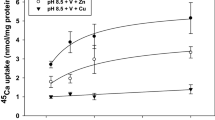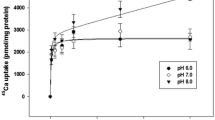Abstract
Rapid lowering of the external pH (“pH jump”) enhances Cl− influx in Chara. Experiments were conducted to distinguish between two factors which have previously been proposed to mediate in the response: raised cytoplasmic pH and lowered cytoplasmic Cl− concentration. It is concluded that the latter alternative is more likely because: i) Cl− influx is reduced at high external pH; ii) influx following the pH jump is never greater than that following pretreatment in Cl−-free solution, which reduces cytoplasmic Cl− concentration (“Cl− starvation”); iii) the joint application of pH jump and Cl− starvation does not result in a greater Cl− influx than does Cl− starvation alone; and iv) addition of NH +4 , which increases cytoplasmic pH, does generate an additional stimulation of Cl− influx following a pH jump. It is suggested that the increased cytoplasmic pH at the end of pretreatment at high external pH decays rapidly during the pH jump, and thus any effect on Cl− influx is so transient as to be undetectable by the methods used. The results are discussed in terms of a reaction kinetic model for 2H+/Cl− cotransport (Sanders, D. and Hansen, U.-P, 1981, J. Member. Biol. 58, 139–153) which describes quantitatively; i) the effects of NH +4 on Cl− influx in terms involving only a change in cytoplasmic pH; and ii) the combined effects of Cl− starvation and NH +4 in terms involving only changes in Cl− concentration and cytoplasmic pH. Conversely, the combined effects of Cl− starvation and pH jump cannot be described by the model if the effect of the pH jump is the consequence of increased cytoplasmic pH. The simple interpretation of experiments on whole cells involving manipulation of \(\Delta \bar \mu _{{\text{H}}^ + } \) (the electrochemical potential difference for protons across the plasma membrane) is questioned in the light of these and previous findings that secondary factors can determine the response of Cl− transport in Chara.
Similar content being viewed by others
Abbreviations
- CPW:
-
Chara pond water
- [Cl−]c :
-
cytoplasmic Cl− concentration
- pHc :
-
cytoplasmic pH
- pHo :
-
external pH
- \(\Delta \bar \mu _{{\text{H}}^ + } \) :
-
transmembrane electrochemical gradient of protons
- Δψ:
-
a membrane electrical potential difference
References
Ballarin-Denti, A., den Hollander, J.A., Sanders, D., Slayman, C.W., Slayman, C.L. (1984) Kinetics and pH dependence of glycine-proton symport in Saccharomyces cerevisiae. Biochim. Biophys. Acta 778, 1–16
Beilby, M.J. (1981) Excitation-revealed changes in cytoplasmic Cl− concentration in “Cl−-starved” cells. J. Membr. Biol. 62, 207–218
Beilby, M.J. (1984) Current-voltage characteristics of the pump in Chara plasmalemma proton. J. Membr. Biol. 81, 113–125
Beilby, M.J., Walker, N.A. (1981) Chloride transport in Chara. I. Kinetics and current-voltage curves for a probable proton symport. J. Exp. Bot 32, 43–54
Bisson, M.A., Walker, N.A. (1982) Control of passive permeability in the Chara plasmalemma. J. Exp. Bot 33, 520–532
Eddy, A.A. (1978) Proton-dependent solute transport in microorganisms. Curr. Top. Membr. Transp. 10, 279–360
Felle, H. (1981) Stereospecificity and electrogenicity of amino acid transport in Riccia fluitans. Planta 152, 505–512
Hansen, U.-P., Slayman, C.L. (1978) Current-voltage relationships for a clearly electrogenic contransport system. In: Membrane transport processes, vol. 1, pp. 141–154, Hoffman, J.F., ed. Raven Press, New York
Jagendorf, A.T., Uribe, E. (1966) ATP formation caused by acid-base transition of spinach chloroplasts. Proc. Natl. Acad. Sci. USA 55, 170–177
Jayasuria, H.D. (1975) Ph.D. thesis, University of Cambridge, Cambridge
Kaczorowski, G.J., Robertson, D.E., Garcia, M.L., Padan, E., Patel, L., LeBlanc, G., Kaback, H.R. (1980) Energetics and mechanism of lactose translocation in isolated membrane vesicles of Escherichia coli. Ann. N.Y. Acad. Sci. 358, 307–321
Keifer, D.W. (1980) Alteration of cytoplasmic pH in Chara through membrane transport processes. In: Plant membrane transport: current conceptual issues, pp. 569–570, Spanswick, R.M., Lucas, W.J., Dainty, J., eds. Elsevier/North-Holland, Amsterdam
Komor, E., Tanner, W. (1980) Proton cotransport of sugars in plants. In: Plant membrane transport: current conceptual issues, pp. 247–257, Spanswick, R.M., Lucas, W.J., Dainty, J., eds. Elsevier/North-Holland, Amsterdam
Ramos, S., Kaback, H.R. (1977a) The electrochemical proton gradient in Escherichia coli membrane vesicles. Biochemistry 16, 848–854
Romos, S., Kaback, H.R. (1977b) The relationship between the electrochemical proton gradient and active transport in Escherichia coli membrane vesicles. Biochemistry 16, 854–859
Raven, J.A., Smith, F.A. (1976) Cytoplasmic pH regulation and electrogenic H+ extrusion. Curr. Adv. Plant Sci. 8, 649–660
Reid, R., Walker, N.A. (1984) Control of Cl− influx in Chara by internal pH. J. Membr. Biol 78, 157–162
Reid, R.A., Moyle, J., Mitchell, P. (1966) Synthesis of adenosine triphosphate by a protonmotive force in rat liver mitochondria. Nature 212, 257–258
Richards, J.L., Hope, A.B. (1974) The role of protons in determining membrane electrical characteristics in Chara corallina. J. Membr. Biol. 16, 121–144
Sanders, D. (1980a) Control of Cl− influx in Chara corallina by cytoplasmic Cl_ concentration. J. Membr. Biol. 52, 51–60
Sanders, D. (1980b) The mechanism of Cl− transport at the plasma membrane of Chara corallina. I. Cotransport with H+. J. Membr. Biol. 53, 129–141
Sanders, D. (1984) Gradient-coupled chloride transport in plant cells. In: Chloride transport coupling in cells and epithelia, pp. 63–120, Gerenscer, G.A., ed. Elsevier/North-Holland, Amsterdam
Sanders, D., Hansen, U.-P. (1981) Mechanism of Cl− transport at the plasma membrane of Chara corallina. II. Transinhibition and the determination of H+/Cl− binding order from a reaction kinetic model. J. Membr. Biol. 58, 139–153
Sanders, D., Slayman, C.L. (1982) Control of intracellular pH. Predominant role of oxidative metabolism, not proton pumping, in the eukaryotic microorganism Neurospora. J. Gen. Physiol. 80, 377–402
Sanders, D., Slayman, C.L., Pall, M.L. (1983) Stoichiometry of H+/amino acid cotransport in Neurospora crassa revealed by current-voltage analysis. Biochim. Biophys. Acta 735, 67–76
Sanders, D., Hansen, U.-P., Gradmann, D., Slayman, C.L. (1984a) Generalized kinetic analysis of ion-driven cotransport systems: a unified interpretation of selective ionic effects on Michaelis parameters. J. Membr. Biol. 77, 123–152
Sanders, D., Smith, F.A., Walker, N.A. (1984b) Mechanism of enhanced H+/Cl− symport in Chara after pH jump. (Abstr.) Plant Physiol. 75, Suppl. 47
Smith, F.A. (1970) The mechanism of chloride transport in characean cells. New Phytol. 69, 903–917
Smith, F.A. (1972) Stimulation of chloride transport in Chara by external pH changes. New Phytol. 71, 595–601
Smith, F.A. (1980) Comparison of the effects of ammonia and methylamine on chloride transport and intracellular pH in Chara corallina. J. Exp. Bot. 31, 597–606
Smith, F.A. (1984) Regulation of the cytoplasmic pH of Chara corallina: response to changes in external pH. J. Exp. Bot. 35, 43–50
Smith, F.A., MacRobbie, E.A.C. (1981) Comparison of cytoplasmic pH and Cl− influx in cells of Chara corallina following “Cl− starvation”. J. Exp. Bot. 32, 827–835
Smith, F.A., Walker, N.A. (1976) Chloride transport in Chara corallina and the electrochemical potential difference for hydrogen ions. J. Exp. Bot. 27, 451–459
Smith, F.A., Walker, N.A. (1978) Entry of methylammonium and ammonium ions into Chara internodal cells. J. Exp. Bot. 29, 107–120
Smith, F.A., Walker, N.A. (1980) Effects of ammonia and methylamine on Cl −3 transport and on the pH changes and circulating electric currents associated with HCO −3 assimilation in Chara corallina. J. Exp. Bot. 31, 119–133
Slayman, C.L., Slayman, C.W. (1974) Depolarization of the plasma membrane of Neurospora during active transport of glucose: evidence for a proton-dependent cotransport system. Proc. Natl. Acad. Sci. USA 71, 1935–1939
Turner, R.J. (1983) Quantitative studies of cotransport systems: models and vesicles. J. Membr. Biol. 76, 1–15
West, I.C. (1980) Energy coupling in secondary active transport. Biochim. Biophys. Acta 604, 91–126
West, I.C., Mitchell, P. (1973) Stoicheiometry of lactose-H+ symport across the plasma membrane of Escherichia coli. Biochem. J. 132, 587–592
Author information
Authors and Affiliations
Rights and permissions
About this article
Cite this article
Sanders, D., Smith, F.A. & Walker, N.A. Proton/chloride cotransport in Chara: mechanism of enhanced influx after rapid external acidification. Planta 163, 411–418 (1985). https://doi.org/10.1007/BF00395151
Received:
Accepted:
Issue Date:
DOI: https://doi.org/10.1007/BF00395151




